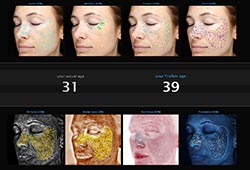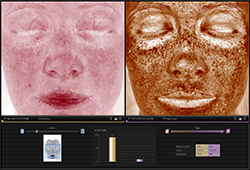VISIA complexion analysis provides side-by-side comparisons, quantitative analysis to track progress over time
VISIA’s multi-point positioning system and live image overlay make it easy to capture perfectly registered images to document progress over time. VISIA easily captures and automatically analyzes left, right and frontal facial views. Personalized, easy to understand customized reports for facial rejuvenation treatment and ongoing skin care.
IntelliFlash®, cross-polarized and UV lighting are used to record and measure surface and subsurface skin conditions. UV photography provides the most complete data set available for sun damage assessment and analysis, including UV fluorescence imaging to reveal porphyrins. Canfield’s RBX® Technology separates the unique color signatures of Red and Brown skin components for unequaled visualization of conditions such as spider veins, hyperpigmentation, rosacea, and acne.

VISIA Truskin Age Report

What are the definitions of the various skin features and how are the features detected?
Spots: Spots are typically brown or red skin lesions including freckles, acne scars, hyper-pigmentation and vascular lesions. Spots are distinguishable by their distinct color and contrast from the background skin tone. Spots vary in size and generally have a circular shape.
Pores: Pores are the circular surface openings of sweat gland ducts. Due to shadowing, pores appear darker than the surrounding skin tone and are identified by their darker color and circular shape. The VISIA system distinguishes pores from spots based on size; by definition, the area of a pore is much smaller than a spot.
Wrinkles: Wrinkles are furrows, folds or creases in the skin, which increase in occurrence as a result of sun exposure, and are associated with decreasing skin elasticity. This skin feature has the greatest variability from image to image as it is highly dependent upon the facial expression of the client. Wrinkles are identified by their characteristic long, narrow shape.
Texture: Texture is primarily an analysis of skin smoothness. Texture measures skin color and smoothness by identifying gradations in color from the surrounding skin tone, as well as peaks (shown in yellow) and valleys (shown in blue) on the skin surface that indicate variations in the surface texture.
Porphyrins: Porphyrins are bacterial excretions that can become lodged in pores and lead to acne. Porphyrins fluoresce in UV light and exhibit circular white spot characteristics.
UV Spots: UV spots occur when melanin coagulates below the skin surface as a result of sun damage. UV spots are generally invisible under normal lighting conditions. The selective absorption of the UV light by the epidermal melanin enhances its display and detection by VISIA.
Red Areas: Red Areas represent a potential variety of conditions, such as acne, inflammation, Rosacea or spider veins. Blood vessels and hemoglobin contained in the papillary dermis, a sub-layer of skin, give these structures their red color, which is detected by the RBX Technology in VISIA. Acne spots and inflammation vary in size but are generally round in shape. Rosacea is usually larger and diffuse compared to acne, and spider veins usually are short, thin and can be interconnected in a dense network.
Brown spots: Brown Spots are lesions on the skin such as hyper-pigmentation, freckles, lentigines, and melasma. Brown Spots occur from an excess of Melanin. Melanin is produced by melanocytes in the bottom layer of the epidermis. Brown Spots produce an uneven appearance to the skin, and are detected in VISIA by RBX.
What factors influence the results of the image session?
A number of factors contribute to the actual scores generated by the VISIA complexion analysis algorithms, including the condition of the skin (cleaned vs. fresh make-up, old make-up, time-of-day), head registration within the booth, facial expression (particularly for wrinkles), stray hair, glare areas resulting from oily skin, etc. Note that the percentile scores were generated for subjects with cleaned skin prior to their imaging session, so results may vary if make-up is NOT removed prior to a patient’s VISIA session.

